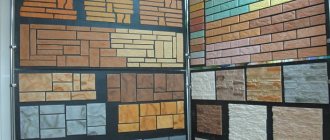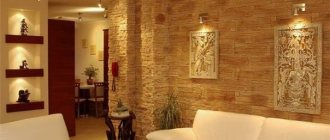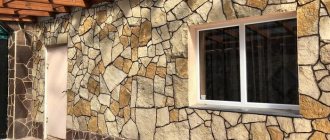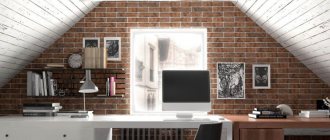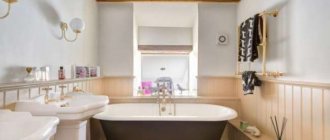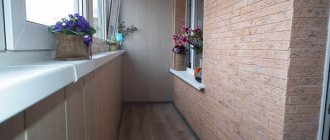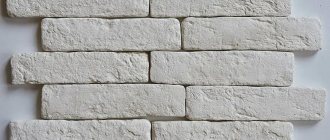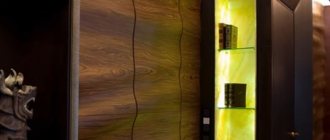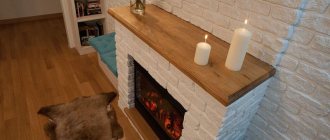Natural stone has been used for interior decoration for a long time. For many centuries, only wealthy people could afford such a luxury. But now everything has changed: relatively recently, gypsum stone was invented for interior decoration, which is inexpensive and is actively used by designers today. It has a huge number of advantages and is suitable for decorating interiors of different styles.
Gray gypsum decorative stone
Features and advantages of the material
Buyers choose modern decorative gypsum stone for these reasons:
- it is inexpensive;
- has low weight;
- easy to install;
- presented in a large assortment.
The finishing stone is made from gypsum, a safe processed mineral, and is therefore suitable for interior decoration of residential premises. It does not need to be sanded during repairs. This artificial material is smooth during the manufacturing process, so there is almost no dust or debris when working with it.
Plaster tiles weigh little, so they are suitable for decorating thin partitions and plasterboard arches. This design does not always withstand the weight of natural material. Artificial stone comes in different colors and textures, so you can use it to create designs in different styles: loft, eco, classic, Italian.
Gypsum decorative stone in the kitchen
DIY gypsum stone
Simple manufacturing technology allows you to cast stone from gypsum at home. all that is required for this is the necessary components, special forms and positive air temperature.
Economic feasibility
Despite the fact that gypsum stones are cheaper than natural ones, their price does not seem quite affordable to everyone. That’s why the idea of making them yourself comes to mind. But is the game worth the candle?
If you need to veneer one or two square meters of the wall, then definitely not. If the area for finishing is large, then the savings can be significant. Judge for yourself. The cost of one square meter of gypsum tiles ranges from 500 to 2000 rubles, depending on their composition, thickness and other nuances. For example, let’s take products in the middle price category: white “Appalachian” tiles costing 720 rubles per square meter. Weight – 15 kg.
Gypsum facing tiles
To cast tiles, experts advise using high-strength G16 gypsum, which costs about 500 rubles per 40 kg bag.
High strength gypsum
But, as practice shows, they are no worse obtained from ordinary building gypsum of a grade no lower than G5. Its price is 270 rubles per 35 kg.
Construction gypsum
Prices for various types of gypsum building mixtures
Construction gypsum
Let’s not save money and consider using more expensive material: a kilogram of dry mixture will cost 12.5 rubles. Accordingly, 15 kg – 187.5 rubles. That is, almost four times cheaper than ready-made tiles. Even if you add the costs of fillers and plasticizers, it is unlikely that the total amount will be more than 200 rubles.
And when using cheap gypsum, it will decrease to 110-120 rubles, provided that the stone thickness remains the same. Reduce the thickness and you will win even more.
But for independent production you also need casting molds. They are also not cheap and can cost from 1.5 to 6 thousand rubles, depending on the size. So these costs are also included in the price.
Stone molds
Forms for decorative stone
Note. You can also make the molds yourself by pouring liquid silicone or polyurethane into the formwork with stones placed on the bottom. But such compositions are not cheap - from 5,000 rubles per 5 kg. Therefore, it makes sense to do this only if you plan to produce stone for sale or if you want to get non-standard products that you cannot find in stores.
DIY mold for artificial stone
Manufacturing technology
Before we begin describing the process itself, remember a few tips:
- The tiles can be given additional strength by adding sand to the solution in a gypsum-sand ratio of 10:1 or slaked lime in a ratio of 6:1;
- the amount of water depends on the quality of the gypsum and is determined experimentally. Typically, about 800 ml of water is required per kilogram of gypsum;
- the solution hardens very quickly, which can be inconvenient at first until automaticity in actions is developed. But the setting process can be slowed down by adding a pinch of citric acid to the water;
- if, on the contrary, it is necessary to speed up the hardening, table salt is added to the water;
- The volume of the solution is also determined experimentally - it should be enough to completely fill the mold, since there will be no time to prepare a new portion. And the excess will simply harden in the mixing container;
- To give color to the stone in the mass, you cannot use ordinary colors. Only special iron oxide inorganic dyes in the form of dry powder are suitable for this.
Powder paint prices
Powder paints
Yellow iron oxide pigment
Orange iron oxide pigment
Prepare everything you need, including a mold, a wide spatula, a container and a mixing tool, and you are ready to begin.
| Step by step photos | Description |
| Place the matrix on the table and check the level. It must be strictly horizontal, otherwise the stones will turn out to be of different thicknesses. |
| Pour water into the container, add gypsum and fillers into it and mix by hand or with a construction mixer. The solution should be homogeneous, fluid and not very thick. It’s better to let it be thinner - the excess water will evaporate. |
| Without hesitation, pour the solution into the mold, filling all the cells. To release air bubbles formed during kneading, lightly shake the mold, quickly move it back and forth and tap on its walls. |
| Using a spatula, level the mixture so that it fills the entire volume and the partitions remain clean. |
| When the plaster has set slightly, apply grooves to its surface with any available tool. When glued to the wall, they will provide better adhesion to the surface. |
| After about half an hour, the plaster will harden and the stones can be removed from the matrix. To facilitate this process, it is bent down and to the sides. |
| We dry the finished stones for another day in a warm, ventilated room. It is advisable to lay it so that there is air access from all sides - on a mesh or a homemade device, as in the photo. |
Video - Making artificial stone at home
You can paint the gypsum stone after installation. But if you need to get different shades, then the pigment is diluted in water and applied with a brush, spray, or simply briefly dip the tile in a bath of dye.
Painting gypsum stone with a brush
Depending on the size of the mold and the amount of free time, you can make up to 10-15 square meters of facing tiles per day. If you don't evaluate your work, the savings are quite noticeable.
Types of material for decorating rooms
The most popular and in demand types of material are:
- brick;
- torn (wild);
- rubble;
- original.
Brickwork is the most commonly used type. Red tiles are suitable for decorating rooms in Provence, country, and rustic styles. It is also used to decorate the fireplace wall. White tiles are used to decorate surfaces in loft and Mediterranean interiors.
It is customary to decorate eco-style interiors with torn and wild bricks. This type of masonry is an imitation of natural stone. Gypsum tiles are similar to slate or other natural material mined from the mountains.
Gypsum decorative stone in the bedroom interior
Finishing rubble stone is also called boulder. It looks like fragments of limestone rocks. Tiles are made in different sizes and uneven shapes. This material will be an ideal decor for the living room of a country house and will go well with natural wood and embroidered textiles.
The original includes the rest of the finishing materials made of gypsum, imitating natural rocks. They differ in shape, color, pattern and are suitable for covering surfaces in interiors of different styles.
Gypsum decorative stone for painting
Video description
The video describes how to apply protective varnish to decorative stone:
Imitation stone harmonizes well with other types of finishes. It can be combined with wallpaper, with lining, with any types of plaster, with paint, with wall panels. This material is considered environmentally friendly, which means it can be used where people with allergies live. Products of this kind are now actively used in the arrangement of residential spaces, premises in children's educational institutions, hotels, and hospitals. The great popularity of decorative stone indicates the practicality of the finish and its high aesthetic properties.
Decorative brick in apartment design
Such gypsum tiles can be used for different installations. Most often, decorative bricks are used to completely or partially cover the walls of a room. You can also use it to highlight doorways or arches in your apartment. A fireplace will look especially beautiful against a brick wall. This tile goes well with wallpaper, natural wood, acrylic paint and other types of coatings.
Decorative stone can be used to decorate not only houses, but also apartments. They can be used to decorate corners and doorways.
Despite the huge number of advantages, decorative brick has its disadvantages. It accumulates moisture and can become deformed. Therefore, if you use it to decorate walls in the bathroom, you need to cover the surface with a protective layer. Tiles also accumulate dust and therefore require special care. In addition, it is fragile and can break off with a small impact.
Gypsum decorative stone on the wall
Laying gypsum-based tiles
Installation of decorative gypsum tiles is subject to certain rules. Before working on laying stone, you need to prepare some tools:
- pencil to mark cutting lines;
- file;
- hacksaw;
- a miter box, which is useful when cutting gypsum stone;
- level;
- spatulas;
- sandpaper;
- drill and nozzle for mixing the solution;
- container for mixing tile adhesive;
- brushes;
- tile adhesive;
- roller and primer;
- kitchen sponges;
- varnish and paint.
Important! After making the tiles, they should be laid out on a flat surface and examined for color changes depending on the viewing angle. If the products change their color, they must be picked up with the “right” side and installation begins.
Before laying the first layer of tile, it is important to determine how horizontal the floor is. This is necessary for smooth installation of products. Then the back side of the tile and the wall must be primed. The primer will take about an hour to dry. During this time, you need to prepare the glue and install the tiles.
The adhesive composition is diluted to a thick mass. You need to apply it to the wall with a comb spatula. It is important to make the layer not too thick. Then you need to press the tile tightly against the wall. The glue squeezed out from under the stone should be removed with a sponge.
You need to try to ensure that the tiles alternate in size from the first row. There should be no repetition. It is important that the pattern when installing a gypsum product is as close as possible to the appearance of natural stone. There are no coincidences in nature. During the process of laying stone, it is important to constantly check the evenness of the masonry.
Trimming tiles in difficult areas is done using a chisel. The edges should be sanded with sandpaper. The saw cuts also need to be sanded. The corners are cut with a miter box. All coating elements must fit tightly to each other.
The joints of gypsum stones are sealed with putty. This composition must be used to treat joints and cutting areas. For this purpose, special bags are purchased. It is quite convenient to squeeze putty out of them. Its remains are removed with a damp sponge. Then all sealed areas should be painted with a brush.
At the last stage, the surface is treated with varnish. This composition must be water based. Now the surface will not be afraid of wet cleaning.
Torn (wild) stone in the interior
This material looks like real uneven pieces of rock. It can imitate marble, limestone, travertine, sandstone, quartzite, granite and others. Therefore, decorative torn stone comes in different colors and textures. Gray or brown material is suitable for decorating the interiors of country houses. Textured solid wood furniture will be ideally combined with it. A coating that imitates marble is suitable for classic interiors. Elements made from it and gypsum borders look beautiful against the background of Venetian plaster.
Gypsum decorative stone in an English interior
What is it, composition
Gypsum stone is an artificial material actively used for finishing and decorating interior and exterior walls. The main component of the stone is the natural material gypsum. Other elements are also included. Coloring pigments are used to give the stone a specific color . To increase strength, special adhesives and modifiers are used. A mandatory component is water , the only requirement for which is the absence of impurities and aggressive chemical compounds.
Artificial gypsum stone in the form of tiles. Photo by Leroy Merlin
Different manufacturers can add other components to the mixture : sand, slaked lime, marble chips, plasticizers and other additives that affect the characteristics and appearance of the stone. Therefore, materials based on gypsum from different brands are often not very similar and differ in properties, sizes and colors. But the differences in parameters are insignificant. The production technology is quite simple - the mixture of components is poured into a special mold and left until completely hardened.
Rubble stone
Its structure is similar to that of the wild one. Rubble is the name given to flat pieces of rock, the largest side of which is no more than 50 cm. Decorative material comes in all shades of brown and gray.
Rubble stone is suitable for decorating walls in country houses. It fits perfectly in the interior with natural wood.
This material does not look as bright as torn stone, so it acts as an ideal background for other finishing materials and pieces of furniture. They can decorate part of the wall in the bedroom, in the hallway, in the toilet, in the bathroom or in the kitchen. Here you can decorate part of the wall with similar material and make a kitchen apron out of it.
Booth is ideal for eco-style interiors. Try combining it with photo wallpapers that depict landscapes or parts of green plants.
Gypsum decorative stone in the interior of a country house
Original stone for a modern interior
Designer coating is made for a specific project. It may have a special texture, unexpected color or shape. If such material is coated with gold paint, it will be suitable for an art deco style interior.
Interiors with walls lined with white gypsum bricks look impressive. White color makes the room larger and fills it with air.
And if the brick is covered with red or some calm color, it will make the loft more lively and interesting. This material is not universal and is not suitable for decorating all interiors.
Gypsum decorative stone for fireplace cladding
Decorative stone made of gypsum in interior design
Today, gypsum stone is used in different ways in interior design. They are decorated with:
- walls;
- corners;
- doorways;
- niches;
- balconies;
- fireplaces.
Gypsum decorative stone in the living room interior
For example, walls can be decorated with similar material in whole or in part. In modern interiors, only one wall is often laid with such bricks. A similar technique is used to decorate balconies - here the surface opposite the window is decorated. If the room has a fireplace, then the wall near which it is installed can also be lined with natural stone. Corners, niches and doorways trimmed with brick or artificial rubble look advantageous.
Gypsum decorative stone on the corner
Briefly about the main thing
When creating modern interiors, decorative stone made from gypsum is used very widely.
It is inexpensive, has excellent decorative qualities, is available in a wide range, and the finished cladding is not capable of harming human health.
Installation of artificial tiles is extremely simple: they are placed on a cement or gypsum adhesive composition on a previously cleaned and repaired surface. The seams are filled with grout after a day. At the final stage, the gypsum stone must be varnished.
Ratings 0
Wall decoration
A brick wall will become the center of any room. Therefore, in the early stages of renovation, you need to decide whether you will use gypsum material in the finishing work. If yes, you need to decide on the placement of light sources.
A wall made of artificial stone should be noticeable. There is no need to install tall cabinets next to it.
This texture will be clearly visible in daylight, so it is more logical to decorate the wall located opposite the window with brick or clinker stone. Gypsum brick can also be glued to the wall in the hallway, but then you need to place several sconces on it.
Gypsum decorative stone in the dining room
In the living room, a sofa and a clock with a large dial will look good against the background of brickwork.
Gypsum decorative stone with raw edges
Decor of corners and doorways in the interior
The interiors look cozy, with doorways and corners lined with artificial stone. This technique is often used in rooms stylized as old Europe. A restaurant hall or hallway in an ordinary apartment will turn into an Italian courtyard if the arches are decorated with red brick.
Use decorative bricks to decorate the arches
To decorate the arches of interiors in eco-style, rubble or torn stone of gray, beige, or sand color can be used. In loft rooms, you can also make brick doorways, but the gypsum tiles will need to be painted with acrylic paint in a calm color.
Gypsum decorative stone for brick
Decor of niches in the wall
Today, niches are made in the walls of living rooms, hallways and bedrooms. They perform a decorative function and replace ordinary wooden shelves. Niches are made of plasterboard and gypsum stone is often used for decoration.
Gypsum decorative stone in the interior of a chalet
There are several options for finishing wall niches. Only the back wall can be finished with stone, and the sides can be left white. You can do the opposite - paint the inside of the niche beige or creamy, and trim the corners of the niche with red brick.
Gypsum stone in home decor
To make the recesses in the walls look beautiful, you need to carefully consider the lighting. It is advisable to install spotlights or sconces in it. With this lighting, the texture and shade of the stone will be clearly visible. You can put vases, figurines, and flower pots in the niche. The color of decorative items should contrast with the tiles. Objects made of white ceramics will look ideal against a background of brown stone, and bright metal vases in an oriental style can be placed in a niche trimmed with light decorative limestone.
Gypsum decorative stone in the bathroom
Cladding the wall around the fireplace
If the room has a fireplace, it is best to decorate it and the wall around it with decorative stone. This design option is suitable for interiors of almost all styles, with the exception of techno and minimalism.
The fireplace and the wall around it are most often faced with red brick. But you can deviate from this classic rule and lay out the surface with rubble. Beige plaster and decorative stone go well together.
Gypsum stone in the decor of a private home
Artistic design of gypsum tile finishing
If ready-made tiles are purchased for finishing the wall, after grouting the joints it is necessary to perform a final polishing. If the shade of the grouted joints does not match the color of the tiles, they can be painted with water-based paint. When the paint has dried, the seams should be covered with a layer of colorless varnish.
If the stone is made by hand, it must be painted with acrylic. First you should color the colorless stones. Then make stains on top with paint of a different shade. Only after this are the seams painted over.
A day after the paint layer has completely dried, the finish should be coated with a colorless acrylic-based varnish. This will protect the tiles from mechanical damage and simplify maintenance.
Decorating a balcony with decorative bricks
If you are planning to remodel your balcony, use decorative bricks to decorate it. Here, with constant natural light, this material will look especially impressive.
Gypsum decorative stone in the hallway
If the balcony is converted into a winter garden, one of the walls can be finished with brown rubble. Rattan furniture and wooden shelves will fit into this interior. You can also make an office from the balcony. To make the room seem larger, the walls are decorated with small bricks and covered with white paint.
Gypsum decorative stone in Mediterranean style

